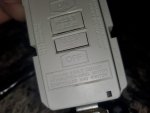SSDriver
Senior Member
- Location
- California
- Occupation
- Electrician
The discussion this far was about dead front GFCIs that fit in a handy box, bit GFCI breakers. GFCI breakers would qualify as a disconnect device without question. The issue in this thread is if the LOCAL disconnect required for a HARD WIRED dishwasher can be a dead front GFCI unit in the wall nearby.Eh? GFCI breakers have ON AND OFF marked on them (required) and are usually not switch rated.
Per the UL Guide Information Sheet for GFCIs, if they have buttons marked "on" and "off" they are also listed as disconnects/motor controllers....
So these say "ON/OFF" on them, but I don't see anything in their specifications which make it an approved disconnect switch.
How does that fit with the concerns Golddigger/Jraef mentioned in the previous post? If they are unpowered, is it guaranteed that pressing the "Off/Test" button will leave the load side disconnected when power is restored?Per the UL Guide Information Sheet for GFCIs, if they have buttons marked "on" and "off" they are also listed as disconnects/motor controllers.
Yes, but is a magnetic motor starter useable as a disconnect? I can put an On-Off button on the over, so would that make it qualify?Per the UL Guide Information Sheet for GFCIs, if they have buttons marked "on" and "off" they are also listed as disconnects/motor controllers.
The guide says " Products with "ON" and "OFF" markings have been additionally covered under Motor Controllers, Mechanically Operated and Solid-state (NMFT). "How does that fit with the concerns Golddigger/Jraef mentioned in the previous post? If they are unpowered, is it guaranteed that pressing the "Off/Test" button will leave the load side disconnected when power is restored?
Cheers, Wayne
Maybe, but that does not make them suitable as a disconnect per 430.109.The guide says " Products with "ON" and "OFF" markings have been additionally covered under Motor Controllers, Mechanically Operated and Solid-state (NMFT). "
The dead front GFCIs are manual motor starters.
That UL file number is the same for Soft Starters, which are NOT suitable to use as a disconnecting device.(6) Manual Motor Controller. Listed manual motor controllers
additionally marked "Suitable as Motor Disconnect"
shall be permitted as a disconnecting means...
Yes they do. Discussion is about "blank face" GFCI's that mount in a device box being used as a "disconnecting means" within sight of an appliance.Eh? GFCI breakers have ON AND OFF marked on them (required) and are usually not switch rated.
I question that.This can't happen on newer GFCIs, but it the ouput hot and N are swapped, then when the GFCI trips the N opens and the hot is hot.
This is why on portable GFCIs they are two pole IE both the hot and N are switched.
A GFCI kind of meets the definition of a disconnecting means..." A device or group of devices..."
But in 422.31 is the requirement for disconnecting means, permanently connected appliances, and a GFCI does not meet that requirement

Did it open the contacts when you pressed "off" while not powered? If it is same working components as a GFCI receptacle (just no receptacles) I doubt it will. And the modern ones will not "set" unless pressing the reset (on) button while powered, as long as line and load conductors are landed at proper terminals, this is because of how they are designed to lock out on a line/load miswiring incident.In my video I said I "tripped" it while it was unplugged. I should correct myself before someone else does. I pressed the off button while it was unplugged. lol
Did it open the contacts when you pressed "off" while not powered? If it is same working components as a GFCI receptacle (just no receptacles) I doubt it will. And the modern ones will not "set" unless pressing the reset (on) button while powered, as long as line and load conductors are landed at proper terminals, this is because of how they are designed to lock out on a line/load miswiring incident.
If you think about it, polarity as well as line/load reversal really doesn't matter when there is no receptacle on the face of it.I should add, you can actually feel it and hear it click when you press off (with or with out power on the line side. I decided to try two other tests and got interesting results.
Additional Test 1: Reversed the Hot and Neutral on the Line side.(hot on neutral, neutral on hot)
Results: GFCI still works as it should and light functions properly. Switch still turns off load with or without power applied. GFCI trips with my GFCI tester.
Additional Test 2: Reversed Line and Load. (Applied power to load instead of Line),
Results: GFCI will show a green light at the bottom with contacts open (in the off/tripped position). It will not reset, and will not put power to the line side. No red lights.
So it seems the controls are not polarity specific (I would not do this on a real install). The green light only checks for power on the load terminals and doesn't care if the contacts are open or closed.
That does make sense, I was curious about a few things and figured I would test it out while I still had everything on the counter.If you think about it, polarity as well as line/load reversal really doesn't matter when there is no receptacle on the face of it.


